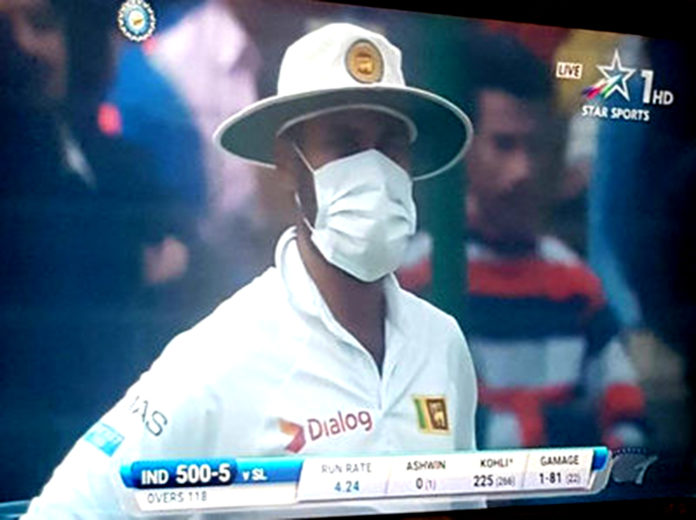Not that Delhiites needed reminding but the sight of Sri Lankan cricketers on the Feroz Shah Kotla cricket field with masks on has once again driven home the dangerous air quality conditions that Delhi is grappling with.

At 3 pm on Sunday the air quality index monitor at Anand Vihar was at the “hazardous” level with the PM10 level at 384 and PM 2.5 level at 310. PM10 is particulate matter 10 micrometers or less in diameter, PM2.5 is particulate matter 2.5 micrometers or less in diameter. According to the World Health Organisation chronic exposure to both variants of particulate matter can increase the “risk of developing cardiovascular and respiratory diseases, as well as of lung cancer”. The last time air quality dipped to similar levels, the Indian Medical Association had said breathing this air is equivalent to smoking 50 cigarettes per day.
A Lancet study published last month estimated that some half a million Indians died prematurely in 2015 because of air pollution. The world over diseases caused by pollution were responsible for an estimated 9 million premature deaths in 2015—16% of all deaths worldwide—three times more deaths than from AIDS, tuberculosis, and malaria combined and 15 times more than from all wars and other forms of violence.
“Pollution is much more than an environmental challenge – it is a profound and pervasive threat that affects many aspects of human health and wellbeing. It deserves the full attention of international leaders, civil society, health professionals, and people around the world,” co-lead of The Lancet Commission for Environment and Health Professor Philip Landrigan, Icahn School of Medicine at Mount Sinai, USA had said while releasing the study.The Commission had reinforced what had long been known.
The effects of pollution on children are even more damaging than in adults. A quarter of all deaths in children younger than 5 years are caused by exposure to an unhealthy environment. Young children are particularly vulnerable to environmental toxicities because of their small size and developing organs, and their rapid periods of growth and development, especially in utero and in infancy.
Early exposure to environmental stressors can result in disease that will remain throughout the life course. For example, high levels of particulate matter in air is associated with preterm birth and low birthweight, both of which increase a newborn’s risk of developing asthma in later life. Similarly, exposure to lead via the placenta, breastmilk, or directly can result in neurodevelopmental defects, cognitive impairment, autism, or attention-deficit hyperactivity disorder, which can result in lower IQ, socioeconomic status, or social mobility in adulthood. Lead poisoning in early life results in mild to moderate mental retardation in approximately 600 000 children a year. Emerging environmental hazards, such as the disposal of electronic waste, pose new threats of toxic exposure.
Although pollution caused by lead, asbestos, dichlorodiphenyltrichloroethane (DDT), polychlorinated biphenyls (PCBs), and the ozone-destroying chlorofluorocarbons are in decline but newer synthetic chemicals that have entered world markets in the past 2–3 decades.


